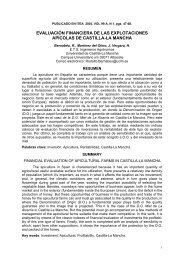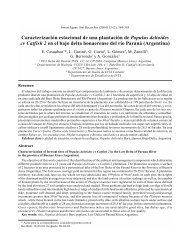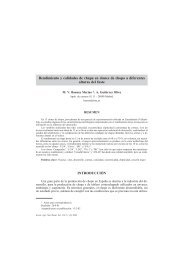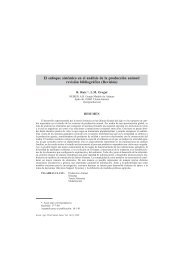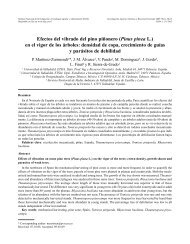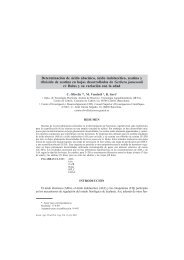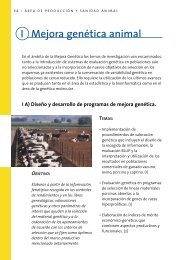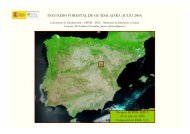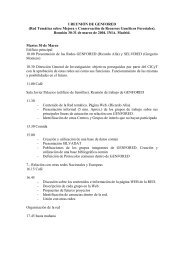Status of medicinal and aromatic plants in - Inia
Status of medicinal and aromatic plants in - Inia
Status of medicinal and aromatic plants in - Inia
You also want an ePaper? Increase the reach of your titles
YUMPU automatically turns print PDFs into web optimized ePapers that Google loves.
22<br />
WORKING GROUP ON MEDICINAL AND AROMATIC PLANTS: FIRST MEETING<br />
HOLARCTIS<br />
PharmEur 38 DAB 44<br />
PALAEOTROPIS<br />
PharmEur 11 DAB 6<br />
NEOTROPIS<br />
PharmEur 9 DAB 3<br />
AUSTRALIS<br />
PharmEur 1 DAB 1<br />
CAPENSIS<br />
PharmEur 1<br />
ANTARCTIS<br />
Fig. 1. Floristic regions <strong>of</strong> the world with the number <strong>of</strong> <strong>medic<strong>in</strong>al</strong> <strong>plants</strong> used <strong>in</strong> the<br />
pharmacopoeia orig<strong>in</strong>at<strong>in</strong>g <strong>in</strong> the different regions (PharmEur = European pharmacopoeia;<br />
DAB = German pharmacopoeia).<br />
Ecology <strong>of</strong> <strong>medic<strong>in</strong>al</strong> <strong>plants</strong><br />
The ecological parameters <strong>in</strong>fluence not only plant growth but also the physiological<br />
conditions <strong>and</strong> <strong>in</strong> parallel the quality <strong>of</strong> <strong>medic<strong>in</strong>al</strong> properties.<br />
• Vegetation ecology<br />
Most <strong>plants</strong> are adapted to grow<strong>in</strong>g <strong>in</strong> a wide variety <strong>of</strong> ecosystems, but some are dependent<br />
on the particular conditions <strong>of</strong> their vegetation unit.<br />
The first example is that <strong>of</strong> the willow species (Salix spp.) provid<strong>in</strong>g "green aspir<strong>in</strong>". The<br />
quality is described <strong>in</strong> the European Pharmacopoeia <strong>and</strong> only a few species conta<strong>in</strong> the high<br />
content <strong>of</strong> salic<strong>in</strong> required. A special problem with these species is the production <strong>of</strong> high<br />
yield. Accord<strong>in</strong>g to distribution maps <strong>of</strong> the most important species, Salix purpurea L. <strong>and</strong><br />
S. daphnoides Vill. <strong>in</strong> Central Europe, the first is fairly equally distributed <strong>and</strong> the latter is<br />
found only alongside alp<strong>in</strong>e rivers. Samples with a high salic<strong>in</strong> content have to be selected<br />
from collections along transects through the gallery forests <strong>of</strong> alp<strong>in</strong>e rivers. Not only is the<br />
high content important but also suitability to cultivation. A very good breed <strong>of</strong> Salix<br />
eventually failed because <strong>of</strong> roe deer forag<strong>in</strong>g lead<strong>in</strong>g to destruction <strong>of</strong> the cultivated crop.<br />
Another example <strong>of</strong> a famous <strong>medic<strong>in</strong>al</strong> plant dependent on very special conditions <strong>of</strong> its<br />
vegetation unit is Spanish arnica (Arnica montana L. subsp. atlantica) that only grows <strong>in</strong><br />
Galicia, northern Spa<strong>in</strong>. Because <strong>of</strong> its special chemical composition <strong>and</strong> lower allergenic<br />
potency the Spanish orig<strong>in</strong> is preferred. The species is under threat <strong>in</strong> its natural habitat<br />
because <strong>of</strong> chang<strong>in</strong>g ecological conditions. Decades <strong>of</strong> wild craft<strong>in</strong>g were not harmful to the<br />
species but the improvement <strong>of</strong> the marshy meadows along the typical rias valleys preferred<br />
by the plant caused disappearance <strong>of</strong> the species.




